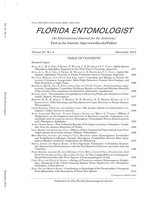Stenoma impressella Busck (Lepidoptera: Elachistidae) is an important oil palm pest and its life history and life table parameters were studied at various temperatures, from 16 °C to 40 °C. Females and males developed successfully into adults between 20 °C and 36 °C. However, no eggs were found at 10 °C and all the adults died after exposure to 40 °C. The developmental time from egg to adult was higher (170.5 days) at 15 °C and lower (76.6 days) at 35 °C. Therefore, temperature has a strong effect on the development of S. impressella from 15 °C to 35 °C. The reproductive period varied between 15–35 °C with 6.82 to 3.24 days for pre-oviposition, 17.5 to 4.89 days for oviposition, and 5.29 to 0.82 days for the postoviposition period. Female longevity was longer than that of the male, at all temperatures. The population growth parameters of S. impressella net reproductive rate (R0), intrinsic rate increase (rm), finite increase rate (λ), mean generation time (T) and doubling time (D) were significantly affected by temperature. Temperature affects S. impressella populations by reducing or increasing their possible occurrence in the palm trees. The effect of temperature on the development, survival and reproduction of S. impressella can be useful for predicting its long-term population fluctuation as an invasive pest of oil palm plantations.
How to translate text using browser tools
1 December 2014
Effects of Temperature on the Development of Stenoma impressella (Lepidoptera: Elachistidae) on Oil Palm in Colombia
Luis C. Martínez,
Angelica Plata-Rueda,
José C. Zanuncio,
Genésio T. Ribeiro,
José Eduardo Serrao

Florida Entomologist
Vol. 97 • No. 4
December 2014
Vol. 97 • No. 4
December 2014
demographic parameters
insect pest
insecto plaga
longevidad
longevity
parámetros demográficos
reproducción




